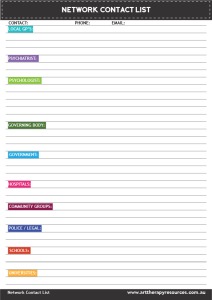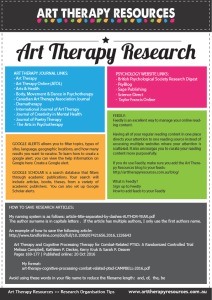THIS POST INCLUDES:
Introduction therapy practice
STEP 1: Are you ready?
STEP 2: Business Model
STEP 3: Set up practice
STEP 4: Client management
STEP 5: Finances
STEP 6: Marketing
STEP 7: Networking
STEP 8: Professional Issues
STEP 9: Personal Issues
STEP 10: Review
Free Download Business Model Worksheet
INTRODUCTION
Most countries have government created websites that provide useful information in starting a new business. Some of these websites also provide specific guidance depending on the industry that you work in, such as helping professions.
STEP 1: ARE YOU READY?
Before making this important decision, you may want to ask yourself a few questions and reflect on your reaction to each question:
- Am I professionally qualified to deliver the services I am offering?
- Do I have the professional experience and skills required to manage a caseload?
- Do I have peer supervision in place?
- Am I confident with my understanding of my legal obligations with my clients?
- Am I comfortable with my knowledge of ethical issues that may arise in managing my clients?
- Do I have the time and financial resources to dedicate to establishing administrative systems within my practice?
- Do I have a contingency in place if I am unable to deliver services for a short or long period of time?
- Do I work best as part of a team environment?
- What is my main motivation for establishing a private practice?
- Can I survive without an income for 1, 3 or 6 months?
- Do I have a vision of how my practice will run?
- Do I need to hire staff?
- Do I understand or have access to professional to help with taxation and business legal obligations?
- What income level do I need to earn? Is this possible with my available time?
- Am I aware of the running costs required to operate my own practice?
- Do I have alternative income earning avenues while my private practice is building?
- Have I established (or know how to establish) a referral network for finding clients?
- How much do I need to invest in starting my private practice?
- Am I good at managing my time well?
This is not an exhaustive list of questions to consider when establishing your private practice, however, these questions will help you explore the possible risks and benefits of starting your own business.
STEP 2: BUSINESS MODEL
- Will you provide therapy one to one, online, in workshops or groups?
- What is the demographics of your preferred clientele?
- Do you intend to focus on one or a few specific psychological specialities?
- Will you be offering your art therapy services only, or physical products as well?
How you define your business model will dictate the rest of your private practice planning. It will determine the facilities you will need, the administration you will need to set up and the way in which you will market your art therapy practice to gain potential clients.
STEP 3: SET UP PRACTICE
This is as simple as having an established intake form in place or a set of automated email responses in place so that you are not wasting your valuable time on repetitive administrative tasks.
Setting up your practice will cover the following areas:
- Office contact methods – phone, answering machine, email
- Office operating hours
- Office location and access to public transport
- Art therapy supplies
- Website
- Office administration – booking clients, taking payment etc
- Business registration
- Office technology requirements
- Financial policies – fees, cancellation, refunds
- Client management considerations
- Financial considerations
This is not an exhaustive list of items to consider when establishing your private practice, however, these areas provide a place for you to start to setting up your private practice.
STEP 4: CLIENT MANAGEMENT
- Client intake
- Client consent
- Client privacy
- Authorisation to release information
- Social media policy
Putting these practices in place will help ensure you are meeting your legal obligations as well as preventing potential boundary issues concerning your client.
Your client management procedures will cover activities within art therapy session as well as how you manage your client information within your office environment.
STEP 5: FINANCES
The key to managing your financial information is to establish a strong recording system from the start. Your software should record data as well as provide you with useful reporting that will enable you to make decisions about your business.
Ideally, your financial system will interact with external sources including your accountant, your bank and the government for taxation purposes.
The more your financial process can be automated means the less time you spend on admin and the more time you can spend on clients.
Setting up your financial system takes some effort in the initial phase, however, once you have your systems in place, you can reasonably rely on them to work without too much intervention from yourself.
Financial considerations you will need to explore include:
- Insurances
- Software for recording income and expenses
- Paying a salary (to self)
- Payroll and income tax
- Superannuation (retirement savings for other countries)
- Client payment methods – cash, credit card etc
- Registering for ABN and GST (relevant business registrations in other countries)
- Producing invoices/receipts for clients
- Business bank account
- Payment from 3rd party groups, eg. Insurance, medicare etc
STEP 6: MARKETING
If you belong to a professional organization, you should check that your marketing meets their guidelines and see guidance if you are unsure. You may also be regulated by government guidelines on how you can market your services.
In Australia, the Australian Competition and Consumer Commission (ACCC) and the Therapeutic Goods Administration (TGA) regulate the advertising of health products and services. Your country will have its own regulatory bodies.
Most organisations suggest the below basic guidelines:
- Refrain from false, misleading or deceptive advertising
- Do not offer gifts, discounts or enticements to persuade your client to use your services
- Clearly state the terms of your therapy service
- Don’t use testimonials for your services due to client privacy and variable results
- Do not create an unreasonable expectation of a “cure” or benefits of treatment
- Do not oversell your therapy skills
STEP 7: NETWORKING
PROFESSIONAL NETWORKING

We have an indepth blog post about professional networking as an art therapist which covers the following topics:
1. Why you need a network
2. Types of Contacts
3. How to build your network
4. Staying connected with your network
You can also download a network contact list template as a pdf or Evernote download.
BUSINESS NETWORKING

We have an indepth blog post about how to establish your business network as an art therapist which covers the following topics:
1. Types of business networks
2. Who is in your network
3. Using your Network
You can also download a network contact list template as a pdf or Evernote download.
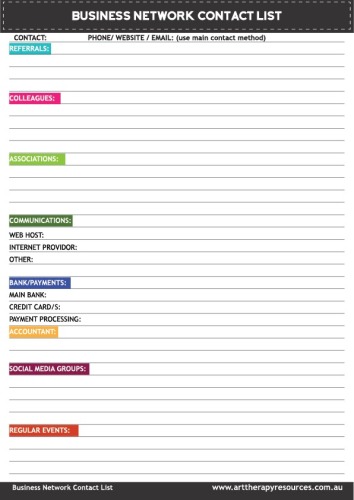
STEP 8: PROFESSIONAL ISSUES
If you’re not sure why joining a professional association can benefit you, you can read more on our blog post: 10 Art Therapy Associations and Organisations
In the blog post, we detail a number of benefits for joining an association including:
- Professional development
- Networking
- Business benefits
- Mental Health advocacy
In addition to connecting with professional organisations, you should also remain informed on developments within the art therapy field and mental health in general.
Staying up to date on art therapy and psychology research provides a number of benefits to your art therapy practice and overall professional development. You may like to read research that is focused on art therapy only or follow research on a specific diagnosis that you specialise in your practice.
Fortunately, with the use of technology, it is easy to stay up to date on new information about art therapy. We’ve written about this process before in a blog post: How To Keep Up To Date On Art Therapy Research
Topics include:
1. Art Therapy Journals
2. Psychology Websites
3. Feedly (news aggregator app)
4. Google Alerts & Google Scholar
5. How to save research articles
You can also download a list of the links and tips to stay updated on research as a pdf or Evernote download.
STEP 9: PERSONAL ISSUES
Therapists are regularly exposed to distressing information through their client’s stories. The exposure to this information over a long period can have a cumulative effect and it may be some time before the effects are noticed.
Regularly engaging in self-care activities can help reduce stress and provide an outlet for the professional burden of providing therapy services.
Self-care helps to create a framework in which therapists can learn to identify the impact of personal and professional stresses that need addressing. Self-care can be useful when exercised during and after a stressful event, and can also act as a preventative measure for future stresses.
Self-care is beneficial by:
- Addressing existing physical issues as well as promoting future good physical health
- Addressing existing psychological issues as well as providing preventative care for future psychological health
- Immediate stress reduction and management of future stress coping mechanisms
- Facilitating emotional support
- Establishing supporting interpersonal relationships – personally and professional
- Establishing a balance between personal and work life
In addition to developing a self-care plan to regularly address ongoing stresses, it is important for private practice therapists to establish a contingency plan for their practice in the event they are unable to provide therapy for their clients.
If this occurs over a short term period, you may simply be able to reschedule your clients to another time in the near future, however, if you need to be absent from your business for an extended period, you may need to refer your clients to another therapist or hire a therapist to take your case load within your own business.
Having a plan in place for these possible scenarios will help you minimize further stress by reducing the impact of making difficult decisions at a time when you are already under pressure.
STEP 10: REVIEW
You should consider the below items for your review:
- what is working
- what needs changing
- where does most of your revenue come from
- how can systems and procedures be improved
- how can time management be improved?
If you are recording your finances correctly, you should have access to financial reports that will enable you to analyse income and expenses over a period of time with a view to increasing revenue and reducing or streamlining expenses.
If you have an online presence on a website or social media, use available reporting mechanisms to analyse how your private practice is performing online through website visits, newsletter subscribers, and social media interactions.
It may seem like there is a vast array of analytics you can become overwhelmed by, however, you can set up a simple tracking system to keep check of your most important metrics and then review them each month.
Need help with setting up your Therapy Practice admin policies and procedures?
If you need help to set up your Therapy Practice business, we have an Admin Package in the store which contains a large collection of essential business documents
The Admin Package is available in 3 formats, including Evernote, Scrivener, and Microsoft Word.
You can read more about the packages in our store HERE.



BUSINESS ADMIN
- Business Details
- Accounts
- Contacts
- Financial Policies
- Fee Schedule
- Cancellation Policy
- Refund Policy
- Legal Policies
- Copyright
- Disclaimers
- Terms of Use
- Privacy Policy
- Business Trackers
- Social Media Tips
- Business Admin Maintenance
- Calendars
BUSINESS DEVELOPMENT
- Business Goals
- Project Template
CLIENT ADMIN
- Client Intake Checklist
- Client Call Log
- Consent for Services
- Client Privacy Policy
- Authorisation to release information
- Social Media Policy
EMAIL & LETTER TEMPLATES
- Inquiry Reply
- Referral Request
- Reminder Late Payment
- Response for psychological report
- Response to subpoena
We also offer a Document Creation service for any other template documents that want to use in your business.
You can read more about this service in our store HERE.

FREE DOWNLOAD: Business Model Worksheet
SIGN UP below to download the FREE Business Model Worksheet
Use the worksheet guide to define your art therapy business model.
Download the FREE Business Model Worksheet
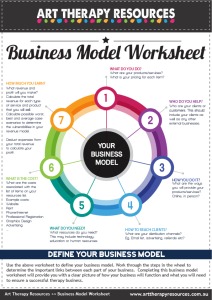
BUILD YOUR ART THERAPY REFERENCE MATERIALS:
Pin this image to your Pinterest board.
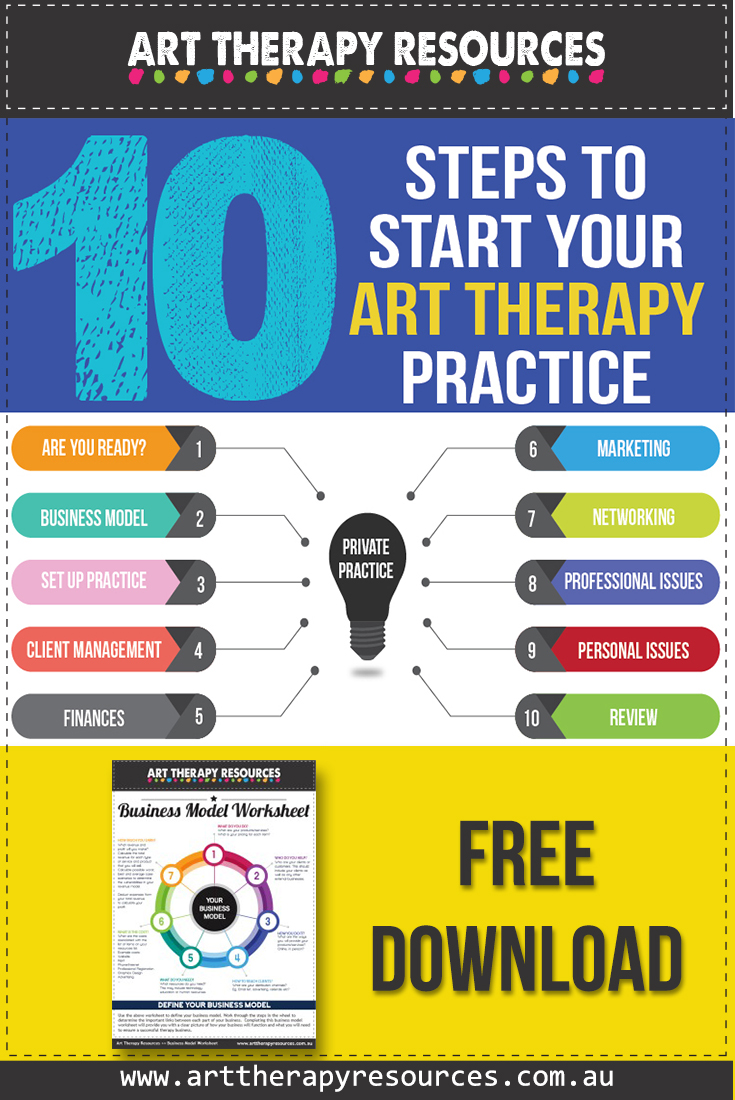
SHARE KNOWLEDGE & PASS IT ON:
If you’ve enjoyed this post, please share it on Facebook, Twitter, Pinterest. Thank you!

